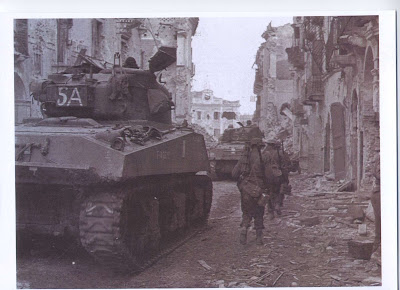During the World War II
Ortona was considered a strategic point both from German and Anglo American
troops. In fact it was included in the so-called Gustav line, a line ideally
connecting Ortona to Cassino, a city in the region of Lazio, thus dividing Italy
into two parts just in the middle. In Ortona German and Canadian troops fought
a terrible battle, in the very heart of the city and for this reason the town
was called the “little Stalingrad”.
tanks of allied troops in Corso Vittorio Emanuele
the main street of the city
On
the first days of December 1943 Canadians arrived from the south part of Ortona,
facing the German army and air force, which destroyed the whole town including
the harbour and the Cathedral. The siege lasted for about seven months and the
most terrible fight was on the 22nd of December. The population of Ortona was compelled
to leave the homes and moved to the countryside but a few people decided to
stay in town. Many of them died of starvation, cold or under the bombings.
Ortona was awarded “Gold Medal” for the large number of civilians killed during
the siege. A lot of them were children, women and old people.
band concert of the troops in front of the theatre "Francesco Paolo Tosti"
on the occasion of the
liberation
On the 28th December 1943 the
city of Ortona was finally freed by the Canadians but the people coming back to
their homes, found only destruction and death.
image of the dome of the
cathedral destroyed
it is the symbol of the end of the battle
The class 3 F thanks to the historical
Canadian archive for the photographs






THE LITLE STALINGRAD
ReplyDeleteIn July 1943 the Allied Armies invaded Italy because they wanted to free the whole country but Hitler ordered to his Generals to defend the ground but in 1945 they surrendered after a bloody battle. German troops occupied the central Italy and they strengthened the three Italian fronts: the Gustav line,, the Barbara line and the Reinhard line; in particular the Gustav line divided the peninsula into two parts with Ortona on the Adriatic coast and Cassino on the Tyrrhenian coast.
In spring 1943 some defensive systems were installed in Ortona such as an alarm siren located on the clock tower next to Saitn Thomas Cathedral. It operated when there was a danger such as an air raid.
People listened to the news of the front from the radios.
On 25th July Benito Mussolini was arrested; even though there weren’t any repercussions on politic plans, some Fascists escaped from Ortona.
On 9th September 1943 the King of Italy, together with his family, the court and Marshall Badoglio, left from Ortona’s harbour by a corvette ship called “Baionetta” to go to Brindisi because the allies had just took the control of that city.
A marble tombstone placed in the north pier of Ortona’s harbour recalls that escape.
In memory of all the civilians who died during the home-to-home conflict in Ortona, near the old restored Convent of the Holy Trinity there is a monument made by Cascella, a local sculptor. The document of the Civic Administration of Ortona, through which the city was awarded the gold medal, written in 1948 shows all the names of 1314 victims.
In the city of Ortona there are many places which recall the Battle of Ortona such as the Canadian Cemetery with 2000 allied graves, situated on the hill called St. Donato, the place where a bloody battle took place, with heavy casualties both in the Commonwealth and German troops. Another historical place is Berardi’s House, a strategic site to get to the city of Ortona; the monument called “Il Prezzo della Pace” (the Price of Peace) a gift from the Canadian veterans and placed in Plebiscite Square following to a suggestive ceremony with the Canadian and German survivals.
In the Cider “quadrivio” (four streets junction) the Local Council placed a tank called ATHENA, given by the Canadians in memory of the battle of Ortona, with all the flags of the Allied Countries which contributed to the liberation of the city. The MUBA (Museum of the Battle of Ortona) is a museum showing imagines and pictures of the battle and the city completely destroyed by bombings, together with uniforms, weapons and various objects belonged to soldiers.
ELEONORA, FEDERICO E TOMMASO
class 3 F